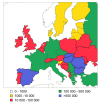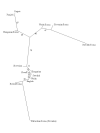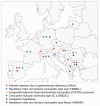Genetic studies of the Roma (Gypsies): a review - PubMed (original) (raw)
Genetic studies of the Roma (Gypsies): a review
L Kalaydjieva et al. BMC Med Genet. 2001.
Abstract
Background: Data provided by the social sciences as well as genetic research suggest that the 8-10 million Roma (Gypsies) who live in Europe today are best described as a conglomerate of genetically isolated founder populations. The relationship between the traditional social structure observed by the Roma, where the Group is the primary unit, and the boundaries, demographic history and biological relatedness of the diverse founder populations appears complex and has not been addressed by population genetic studies.
Results: Recent medical genetic research has identified a number of novel, or previously known but rare conditions, caused by private founder mutations. A summary of the findings, provided in this review, should assist diagnosis and counselling in affected families, and promote future collaborative research. The available incomplete epidemiological data suggest a non-random distribution of disease-causing mutations among Romani groups.
Conclusion: Although far from systematic, the published information indicates that medical genetics has an important role to play in improving the health of this underprivileged and forgotten people of Europe. Reported carrier rates for some Mendelian disorders are in the range of 5-15%, sufficient to justify newborn screening and early treatment, or community-based education and carrier testing programs for disorders where no therapy is currently available. To be most productive, future studies of the epidemiology of single gene disorders should take social organisation and cultural anthropology into consideration, thus allowing the targeting of public health programs and contributing to the understanding of population structure and demographic history of the Roma.
Figures
Figure 1
Romani population size in different European countries The collection of this type of data depends on declared ethnic identity which, in the case of the Roma, can be affected by a number of political and social circumstances. The estimates in the figure are the average of the numbers provided by different sources, such as census data, ministries of internal affairs and human rights organizations [2].
Figure 2
Multilocus comparison between Romani populations from different European countries, autochthonous European populations and populations from north India The polymorphic systems included in the analysis comprised A1A2BO, MN, haptoglobin and Rh (CDE), with a total of 11 independent alleles. Information on these markers was available for the Roma in Slovakia (n = 350) [26], Hungary (n = 507) [11], England (n = 109) [23], Slovenia (n = 350) [27], Sweden (n = 115) [24] and Wales (n = 84) [22], for non-Roma Europeans (n = 5169) and for two north Indian populations, Rajput (n = 175) [34,35] and Punjabi (n = 140) [35,36]. Genetic distances between pairs of populations were computed by means of Reynold's coancenstry coefficient [84] and displayed as a neighbour-joining tree [85]. The robustness of the branches in the tree was assessed with a bootstrap approach [86]. The analysis was conducted using the PHYLIP 3.57c package [87].
Figure 3
Genetic mapping of hereditary motor and sensory neuropathy type Russe (HMSN-R): findings in the region of linkage on chromosome 10q23 This affected family originates from a closed endogamous Romani group where consanguineous marriages are common. The linkage study was conducted using the ABI Prism Linkage Mapping Sets LMS and LMS version 2 (PE Biosystems), with an average intermarker distance of 10 cM. The ABI panel markers flanking the HMSN-R region (shown in blue) presented with different alleles in the affected individuals. Haplotype heterozygosity, resulting from historical recombinations and a recent cross-over event (individual R-11), extended into the 10 cM interval containing the gene and could have resulted in exclusion of the region if homozygosity mapping had been used. In the set of affected families included in the original study [40], the conserved region of homozygosity (red bars) was found to span only <500 kb. Courtesy of Dr. Tamara Rogers.
Figure 4
Distribution of reported founder mutations in Europe The figure is based on available information referring to the following disorders: • Infantile cataracts due to galactokinase deficiency in Bulgaria [44], Austria [95], Switzerland [96], Italy [97], Hungary and Spain [our unpublished findings]. • Hereditary motor and sensory neuropathy - Lom in Bulgaria [37,38], Italy [68], Slovenia [69], Germany [70], Spain [71], France and Romania [55] and Hungary [our unpublished findings]. • Congenital cataracts facial dysmorphism neuropathy syndrome in Bulgaria [41,42], Romania, Hungary and the United States [our unpublished findings]. • Limb girdle muscular dystrophy type 2C in France, Spain, Italy, Germany [43], Portugal [91] and Bulgaria [65,66,93]. • Congenital myasthenia in Serbia, Macedonia, Greece, Bohemia and Germany [46]. • Hereditary motor and sensory neuropathy - Russe in Bulgaria [40], Romania and Spain [our unpublished findings]. The existing data are the product of ad-hoc collaborative studies and are not likely to represent the true spread of Romani founder mutations. The distribution of LGMD2C in Western Europe and in Bulgaria leads to the prediction that the disorder occurs and awaits detection along the entire European migration route, spanning the Balkans and Central Europe. Filling the gaps in the map will be particularly useful in the case of treatable disorders which are strong candidates for newborn screening, such as galactokinase deficiency and congenital myasthenia.
Similar articles
- Mutation history of the roma/gypsies.
Morar B, Gresham D, Angelicheva D, Tournev I, Gooding R, Guergueltcheva V, Schmidt C, Abicht A, Lochmuller H, Tordai A, Kalmar L, Nagy M, Karcagi V, Jeanpierre M, Herczegfalvi A, Beeson D, Venkataraman V, Warwick Carter K, Reeve J, de Pablo R, Kucinskas V, Kalaydjieva L. Morar B, et al. Am J Hum Genet. 2004 Oct;75(4):596-609. doi: 10.1086/424759. Epub 2004 Aug 20. Am J Hum Genet. 2004. PMID: 15322984 Free PMC article. - The P28T mutation in the GALK1 gene accounts for galactokinase deficiency in Roma (Gypsy) patients across Europe.
Hunter M, Heyer E, Austerlitz F, Angelicheva D, Nedkova V, Briones P, Gata A, de Pablo R, László A, Bosshard N, Gitzelmann R, Tordai A, Kalmar L, Szalai C, Balogh I, Lupu C, Corches A, Popa G, Perez-Lezaun A, Kalaydjieva LV. Hunter M, et al. Pediatr Res. 2002 May;51(5):602-6. doi: 10.1203/00006450-200205000-00010. Pediatr Res. 2002. PMID: 11978884 - Origins and divergence of the Roma (gypsies).
Gresham D, Morar B, Underhill PA, Passarino G, Lin AA, Wise C, Angelicheva D, Calafell F, Oefner PJ, Shen P, Tournev I, de Pablo R, Kuĉinskas V, Perez-Lezaun A, Marushiakova E, Popov V, Kalaydjieva L. Gresham D, et al. Am J Hum Genet. 2001 Dec;69(6):1314-31. doi: 10.1086/324681. Epub 2001 Nov 9. Am J Hum Genet. 2001. PMID: 11704928 Free PMC article. - Neuromuscular disorders in the Gypsy ethnic group. A short review.
Navarro C, Teijeira S. Navarro C, et al. Acta Myol. 2003 May;22(1):11-4. Acta Myol. 2003. PMID: 12966699 Review. - Population Genetics of the European Roma-A Review.
Ena GF, Aizpurua-Iraola J, Font-Porterias N, Calafell F, Comas D. Ena GF, et al. Genes (Basel). 2022 Nov 8;13(11):2068. doi: 10.3390/genes13112068. Genes (Basel). 2022. PMID: 36360305 Free PMC article. Review.
Cited by
- "Do my Roma and non-Roma patients need different care?" A brief step-by-step guideline for clinical practitioners.
Belak A, Madarasova Geckova A, van Dijk JP, Reijneveld SA. Belak A, et al. Int J Public Health. 2019 Sep;64(7):1117-1121. doi: 10.1007/s00038-019-01246-9. Epub 2019 May 21. Int J Public Health. 2019. PMID: 31115589 Free PMC article. No abstract available. - Hereditary motor and sensory neuropathy Lom type in a Serbian family.
Dacković J, Keckarević-Marković M, Komazec Z, Rakocević-Stojanović V, Lavrnić D, Stević Z, Ribarić K, Romac S, Apostolski S. Dacković J, et al. Acta Myol. 2008 Oct;27(2):59-62. Acta Myol. 2008. PMID: 19364063 Free PMC article. - The shaping of immunological responses through natural selection after the Roma Diaspora.
Dobon B, Ter Horst R, Laayouni H, Mondal M, Bianco E, Comas D, Ioana M, Bosch E, Bertranpetit J, Netea MG. Dobon B, et al. Sci Rep. 2020 Sep 30;10(1):16134. doi: 10.1038/s41598-020-73182-1. Sci Rep. 2020. PMID: 32999407 Free PMC article. - Admixture of beneficial and unfavourable variants of GLCCI1 and FCER2 in Roma samples can implicate different clinical response to corticosteroids.
Szalai R, Matyas P, Varszegi D, Melegh M, Magyari L, Jaromi L, Sumegi K, Duga B, Kovesdi E, Hadzsiev K, Melegh B. Szalai R, et al. Mol Biol Rep. 2014 Nov;41(11):7665-9. doi: 10.1007/s11033-014-3659-7. Epub 2014 Aug 5. Mol Biol Rep. 2014. PMID: 25091946 - The prevalence and genotype of 21-hydroxylase deficiency in the Croatian Romani population.
Dumic KK, Grubic Z, Kusec V, Braovac D, Gotovac K, Vinkovic M, Vucinic M, Dumic M. Dumic KK, et al. Front Endocrinol (Lausanne). 2023 May 31;14:1170449. doi: 10.3389/fendo.2023.1170449. eCollection 2023. Front Endocrinol (Lausanne). 2023. PMID: 37324261 Free PMC article.
References
- Fraser A. The Gypsies. Oxford: Blackwell Publishers, 1992.
- Liegeois J-P. Roma, Gypsies, Travellers. Strasbourg: Council of Europe Press, 1994.
- Braham M. The untouchables: a survey of the Roma people in Central and Eastern Europe. Geneva: UNHCR, 1993.
- Corretger JM, Fortuny C, Botet F, Valls O. Marginalidad, grupos etnicos y salud. An Esp Pediatr. 1992;Suppl 48:115–117. - PubMed
LinkOut - more resources
Full Text Sources



